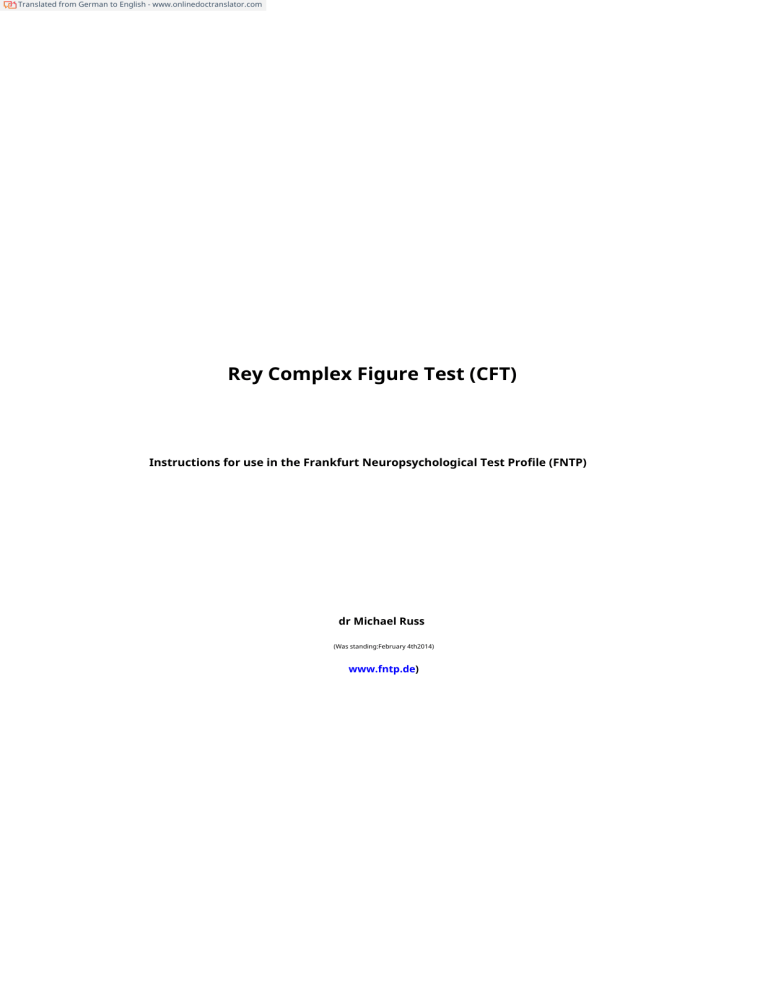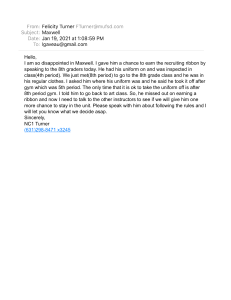
Translated from German to English - www.onlinedoctranslator.com Rey Complex Figure Test (CFT) Instructions for use in the Frankfurt Neuropsychological Test Profile (FNTP) dr Michael Russ (Was standing:February 4th2014) www.fntp.de) Execution and Scoring Sign off: The test template is presented in landscape format for signing (a cross at the top left). Aids such as a ruler or eraser are not allowed, only a pencil is provided. There is no time limit. However, the time is unobtrusively recorded as additional information. If you are obviously overwhelmed, the attempt will be stopped (after 10 minutes at the latest). The instruction reads: "Please try to draw this somewhat complicated figure as accurately as possible. Without a ruler, as it lies here, in the same position and the same size. The time is not important.” Prevent spontaneous rotation of the template if possible! It makes sense to record the course of the signing by numbering the sequence of strokes on a separate sheet and to note down qualitative observations (e.g. neglect sign). Memory: When signing off, no indication is given that the figure should be kept. Immediately after signing, an empty DIN A4 sheet is put down with the request: "Can you draw the figure again from memory?" No repeat presentation of the template afterwards! And after an interval of 30 minutes, which is filled with other test tasks, a second question is asked: "Can you still remember the figure that you had already drawn twice?" Normal drawing: With at least average intelligence, healthy people are able to copy the figure - more or less exactly - so that the end product corresponds well with the template. The linework varies qualitatively (strong, secure lines, painterly dashed, pedantic-exact, timid, thin, weak line ...), the planning behavior leads to success in different ways. The most common is a structurally sound, large-scale development. Often the cross is started at the top left, then the large rectangle is drawn, the triangle is added to the right, then the inner diagonal cross is drawn with the center lines and the upper triangle is added to the outside. The order after completing the large rectangle is very variable, but the procedure is characterized by overview. timid, Anxious and cautious people systematically divide the figure into manageable parts, while others draw large areas using the “outside first” strategy. The main characteristic of the normal drawing is the consistency of shape in the end product, and a "somehow" systematic, goal-oriented approach is to be expected in the behavior of the signs. Score: The evaluation is "semi-objective" and primarily dependent on the experience of the evaluator. Adequate training is therefore necessary. In order to be able to roughly decide whether a drawing looks qualitatively "normal" or "disturbed, pathological" (which is entirely possible and sensible), the "normal" way of drawing must have been seen in as many healthy people as possible. In neurological patients (e.g. M. Parkinson, cerebellar disease, paresis, polyneuropathy), the “purely motor” weaknesses disrupt the assessment. CFT is a "visuoconstructive" test that examines the perception of shape and the purposeful implementation of a visual idea in a graphic program of action. Disorders of simple fine motor skills are better recorded in other ways (Purdue pegboard, tapping). The rule applies: The “trembling”, “crazy”, “extending”, “chunky”, “imprecise” of the strokes caused by the motor are unthinkable in the evaluation. A Parkinson's patient's very crooked, shaky, badlooking drawing may well get a high score afterwards. This “thinking away” of the motor disorder in the assessment is of course objective to a limited extent, but makes sense for clinical diagnostics. Since the memory reproductions - immediately after signing and drawn 30 minutes later are often casually thrown in and taken less seriously in terms of the quality of the drawing, the second rule should apply: the two memory reproductions are rated "more generously" than the first drawing. New memory quotient : As an alternative to the Rey memory variable CFM, a new "memory quotient CQM" is defined. Since the retention performance depends on how much could be recorded as visual perception when signing, i.e. learning, the memory score is related to the signing score. A poor initial performance when signing off should be calculated in the memory score. This variable may prove to be a more meaningful measure of visual memory. CQM is now proposed for the FNTP profile display. However, the experience is not yet sufficient for the final decision. The raw score for CQM is calculated from the sum of both memory performances (S1 and S2, raw scores), divided by the raw score at the badgeninSo.Dhe quotient becomesmultiplied by 100. The agerelated T-scores for this raw score can be found in Table 9b (CQM). Scoring Rey Complex Figure Test (CFT, CFM, CQM) figure area sign off 1 Cross top left outside 2 basic rectangle 3 diagonal cross inside 4 Horizontal center line 5 Vertical center line 6 Small rectangle inside left 7 Line above 6 8th 4 parallel lines inside top left 9 Triangle applied at the top outside 10 Vertical line below 9 inside 11 Circle with 3 points 12 5 dashes in the cross bottom right 13 Triangle attached to the right outside 14 diamond 15 Vertical line in triangle 13 16 Horizontal line in triangle 13 17 Cross outside below (with connection) 18 Square attached outside lower left to hum So Sign off raw value = Sun Raw memory score = S1 + S2 Raw memory quotient=(S1+S2)/So*100 memory 1 memory 2 S1 S2 Maximum value 36 Maximum value 72 All 18 sub-units are assessed both individually and in relation to the overall design. First, the accuracy of the partial image must be checked (existing, correctly drawn, recognizable, only hinted at, imprecise, not recognizable, missing ...), then the relation / position within the overall shape is checked. There are the following combinations, which are rated with 2, 1 or 0.5 points: Partial form considered in itself Part drawn correctly Part inaccurate / incomplete but still identifiable Part missing / not recognizable arrangement correct 2 1 0 Arranged incorrectly 1 1/2 0 History logging sheet Table B8. Rey Complex Figure Test - Copy (CFT) T 80 75 70 68 66 64 62 60 59 58 57 56 55 54 53 52 51 50 49 48 47 46 45 44 43 42 41 40 39 38 37 36 35 34 33 32 31 30 28 26 24 22 20 n M SD 15-25 26-35 36-45 35 35 35 36 34 33 32 31 30 36 34 33 32 31 29 30 28 27 29 28 27 26 25 24 23 22 21 20 19 18 17 16 15 13 11 9 7 6 5 140 29.4 7.0 26 25 24 23 22 21 20 19 18 17 16 15 14 12 10 8th 6 105 29.4 6.0 36 34 33 46-55 56-65 66-75 35 35 35 36 35 34 34 34 33 33 33 32 31 30 32 31 30 29 28 31 29 27 30 29 28 27 28 27 26 25 24 23 22 21 19 17 15 14 13 11 9 8th 7 6 26 25 24 23 21 20 19 17 16 15 14 13 12 10 8th 7 6 5 26 25 24 23 22 21 20 19 18 16 15 14 13 12 11 10 9 8th 7 6 5 5 4 4 4 3 3 3 253 25.0 9.5 2 153 23:1 9.4 2 54 22:1 9.1 36 34 33 32 32 31 31 30 30 29 29 28 27 26 25 24 23 22 21 20 19 18 17 15 13 12 11 10 9 8th 7 6 4 190 28.5 6.8 28 27 26 25 24 22 21 20 19 18 17 16 15 14 12 11 10 9 8th 7 6 5 4 267 27.5 7.6 36 32 36 76-85 PR 100 99 98 96 95 92 89 84 82 79 76 73 69 66 62 58 54 50 46 42 38 35 31 27 24 21 18 16 14 12 10 8th 7 6 5 4 3 2 1 0.8 0.5 0.3 0.1 N=1162 26.7 8.4 Table B9a. Rey Complex Figure Test - Memory (CFM) T 80 75 70 68 66 64 62 60 59 58 57 56 55 54 53 52 51 50 49 48 47 46 45 44 43 42 41 40 39 38 37 36 35 34 33 32 31 30 28 26 24 22 20 n M SD 15-25 70 68 66 63 61 60 58 56 54 53 52 51 49 48 46 44 42 41 40 37 35 33 31 29 27 26 24 23 22 20 18 17 16 15 14 13 12 10 9 7 5 3 1 105 39.5 15.6 26-35 68 66 64 62 60 58 56 54 52 50 48 47 46 44 42 40 38 36 34 32 31 28 26 24 22 20 19 18 16 15 13 11 10 9 8th 7 6 5 4 3 2 1 140 35.0 17.3 36-45 66 63 60 58 57 55 53 51 49 46 44 42 40 38 36 34 32 31 29 27 26 25 23 21 19 18 16 15 13 12 11 10 9 8th 7 6 5 4 3 2 1 189 31:4 15.3 46-55 64 61 59 57 56 54 52 50 48 45 42 40 39 37 35 33 31 30 28 26 25 23 22 20 18 17 15 13 12 11 10 9 8th 7 6 5 4 3 2 1 267 29.9 16.3 56-65 62 60 58 56 54 52 49 47 45 42 40 38 36 35 33 31 29 28 26 24 22 20 18 16 15 14 12 11 10 9 8th 7 6 5 4 3 2 1 253 26.0 16.6 66-75 60 57 53 50 48 45 42 39 35 33 31 29 28 26 24 22 21 20 18 17 16 15 14 13 12 10 9 8th 7 6 5 4 76-85 55 53 51 48 46 43 39 35 32 30 28 26 24 22 20 18 16 15 14 13 12 11 10 9 8th 7 6 5 4 3 3 2 1 153 19.6 15.2 2 1 54 16.6 15.4 PR 100 99 98 96 95 92 89 84 82 79 76 73 69 66 62 58 54 50 46 42 38 35 31 27 24 21 18 16 14 12 10 8th 7 6 5 4 3 2 1 0.8 0.5 0.3 0.1 N=1161 28.8 17.1 The raw score for the variable CFM (memory) is the sum of the two memory runs ( memory &immediately after signing +30 minutes later). The maximum raw score is 72 if the character is drawn from memory with absolutely no errors. Table B9b. Rey Complex Figure Test - Memory Quotient (CQM) T 80 75 70 68 66 64 62 60 59 58 57 56 55 54 53 52 51 50 49 48 47 46 45 44 43 42 41 40 39 38 37 36 35 34 33 32 31 30 28 26 24 22 20 n M SD 15-25 26-35 36-45 46-55 56-65 66-75 230 220 210 205 202 192 187 177 173 170 167 159 157 152 149 147 141 137 132 127 122 117 112 106 101 94 90 84 80 73 69 65 59 52 50 47 40 37 37 31 28 25 20 122 134 46 220 210 200 190 187 178 173 163 160 157 156 152 147 143 138 132 128 121 115 110 105 99 92 84 78 72 69 62 57 51 47 41 35 34 31 28 25 20 15 10 5 2 0 167 120 52 210 205 200 190 185 173 167 153 149 143 139 133 127 123 118 114 110 105 101 95 91 87 81 74 70 64 60 53 51 45 40 35 33 29 25 20 15 10 8th 6 4 2 0 229 106 46 210 205 195 175 170 165 160 149 145 138 135 129 124 120 114 110 107 103 101 95 91 87 81 74 70 64 60 53 51 45 40 35 33 29 25 20 15 10 8th 6 4 2 0 352 105 52 205 200 192 176 170 161 155 142 138 132 127 122 118 112 108 102 98 92 87 81 79 74 70 67 62 59 54 50 46 41 39 34 31 28 25 20 15 10 8th 6 4 2 0 355 96 52 190 185 180 175 170 157 150 136 132 127 121 115 110 107 100 97 90 87 80 73 70 65 59 52 46 41 38 33 30 25 22 19 15 13 11 9 7 5 5 3 2 1 0 257 82 52 76-85 180 175 170 160 152 140 134 122 115 110 102 106 91 85 79 74 67 60 55 49 45 40 36 30 27 24 20 17 15 13 12 11 10 9 8th 7 6 5 4 3 2 1 0 93 65 51 Raw value of this table is the memory quotient (S1 + S2 divided by the raw score of Badge Pass So and multiplied by 100,see scoring sheet). PR 100 99 98 96 95 92 89 84 82 79 76 73 69 66 62 58 54 50 46 42 38 35 31 27 24 21 18 16 14 12 10 8th 7 6 5 4 3 2 1 0.8 0.5 0.3 0.1 N=1553


